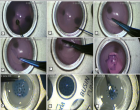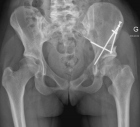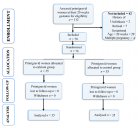About Federal University of Rio de Janeiro
Federal University of Rio de Janeiro
Articles by Federal University of Rio de Janeiro
Study of body composition, physiological variables in Grade III obese submitted to arm ergometer test
Published on: 23rd August, 2017
OCLC Number/Unique Identifier: 7317606261
Introduction: Number of obese people is growing on a daily basis in Brazil, including morbid obese ones, but there is still a lack of studies with this subject. Due to this, the main goal of this study was to identify body profile, physiological variables behavior and oxygen consumption in grade III obese women, submitted to an ergospirometric test in arm ergometer.
Method: Take part in this study, thirteen (13) female grade III obese patients between 20 and 40 years. They were submitted to an electric bioimpedance test for body composition measurement and an Ergospirometric test in arm ergometer for oxygen consumption, heart rate, and oxygen saturation, systolic and diastolic arterial pressure, resting and after exercises, analysis.
Results: The patients revealed a BMI of 46.5±3.81 kg/m², 51.9±1.59% of body fat percentage. The patients reached 168.2±4.57bpm of heart rate, didn’t make any hypertensive response to the effort reaching an arterial pressure of 171.1±22.15mmHg x 87.5±4.18mmHg. Oxygen saturation was 98±0.71% and oxygen consumption peak was, also in average, 12.3±2.75ml.kg.min-1.
Conclusion: It was verified that there was no oxygen saturation drop nor hypertensive response and all of the patients reached the maximum heart rate.
Influence of retreatment in the formation of dentinal microcracks in mandibular molars filled with a calcium silicate based sealer
Published on: 9th April, 2021
OCLC Number/Unique Identifier: 9124848008
Introduction: In endodontically treated teeth, dentinal defects such as microcracks can progress to a vertical root fracture and lead to tooth loss.
Objective: The present study aimed to evaluate, by micro-computed tomography analysis, the formation of dentinal microcracks during filling removal in endodontic retreatment of root canals filled with gutta-percha and Total Fill BC bioceramic sealer.
Methods: Twenty mesial roots of mandibular molars were instrumented and obturated with gutta-percha and Total Fill BC sealer and then the filling material was removed with rotary Protaper Retreatment files. The specimens were scanned before instrumentation, after filling and after retreatment. The transversal images obtained after filling were compared with the images obtained after removal of the filling material. A descriptive statistical analysis was performed.
Results: Among the 24.444 cross-sections analyzed, 5.67% presented some type of dentinal defect, with 0.51% in the initial images, 2.58% in the post-filling images and 2.58% in the post-retreatment images. All the dentinal defects identified in the images obtained after the retreatment were already present in the corresponding images after the filling. New dentinal microcracks were not observed after removal of the filling material.
Conclusion: Retreatment of mesial roots of mandibular molars filled with a silicate-based root canal filling material do not influence the formation of dentinal microcracks.
Evaluating cortical bone porosity using Hr-Pqct
Published on: 27th August, 2019
OCLC Number/Unique Identifier: 8465497330
This work aims to evaluate cortical porosity through a high-resolution peripheral quantitative micro-tomography in a group of 47 patients. All patients, in vivo, were subjected to the medical care protocol of the University Hospital Clementino Fraga, 020-213. Patients were women aged from 37 to 82 years old, who did not present fractures in their lower and upper limbs, all of them showing good health. During screening, they were required to have normal BMD (as determined by DXA; T-score ≥ 1.0) and no low-trauma fractures history. The exclusion criteria for all the individuals enrolled in this control study include, for example, alcoholism, chronic drug use, and chronic gastrointestinal disease. Male patients ranging from 42 to 79 years old presented the same health issues as women group. Results showed an increase in the amount of pores on the cortical bone of the evaluated patients over time; however, this increase was also observed in pore diameter, as well as a decrease in the border between the cortical and trabecular bone, indicating a deterioration in cortical bone quality over the years.
Influence of retreatment in the formation of dentinal microcracks in mandibular molars filled with a calcium silicate based sealer
Published on: 8th April, 2021
Introduction: In endodontically treated teeth, dentinal defects such as microcracks can progress to a vertical root fracture and lead to tooth loss. Objective: The present study aimed to evaluate, by micro-computed tomography analysis, the formation of dentinal microcracks during filling removal in endodontic retreatment of root canals filled with gutta-percha and Total Fill BC bioceramic sealer. Methods: Twenty mesial roots of mandibular molars were instrumented and obturated with gutta-percha and Total Fill BC sealer and then the filling material was removed with rotary Protaper Retreatment files. The specimens were scanned before instrumentation, after filling and after retreatment. The transversal images obtained after filling were compared with the images obtained after removal of the filling material. A descriptive statistical analysis was performed. Results: Among the 24.444 cross-sections analyzed, 5.67% presented some type of dentinal defect, with 0.51% in the initial images, 2.58% in the post-filling images and 2.58% in the post-retreatment images. All the dentinal defects identified in the images obtained after the retreatment were already present in the corresponding images after the filling. New dentinal microcracks were not observed after removal of the filling material. Conclusion: Retreatment of mesial roots of mandibular molars filled with a silicate-based root canal filling material do not influence the formation of dentinal microcracks.

If you are already a member of our network and need to keep track of any developments regarding a question you have already submitted, click "take me to my Query."



















































































































































